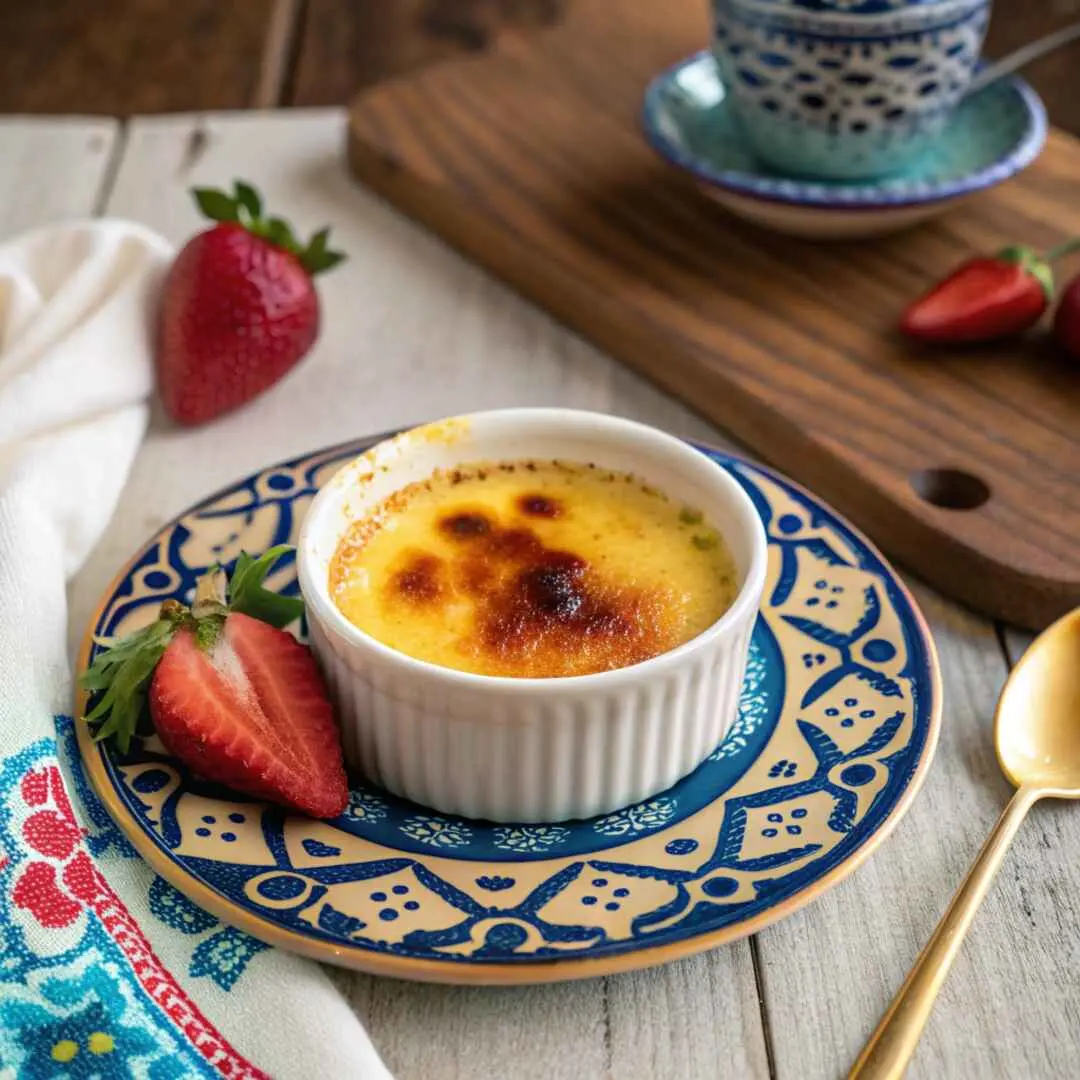Looking for a comforting dessert that’s creamy, traditional, and full of family history? The jericalla recipe brings all of that and more. A beloved custard dish from Guadalajara, Mexico, jericalla combines the silky smoothness of flan with the toasty top of crème brûlée—but with its own identity. In this article, we’ll explore the origins of this dessert, how it’s made, and tips for serving it just right. You’ll also learn how it fits into my family’s kitchen story, and how to make it your own. Let’s dive into this sweet tradition with simple steps and bold flavor.
Table of Contents
Table of Contents
The creamy custard I never forgot
There’s a moment in every Mexican kitchen when everything just feels like home. For me, that moment happened the first time I made jericalla with Grandma. While the scent of cinnamon filled the air, she stood by the oven with her usual knowing smile, telling me how this dessert reminded her of her own childhood in Jalisco.
I’d grown up with flan, arroz con leche, and even tres leches cake—but jericalla was different. Simpler, somehow. Softer. It didn’t try too hard, and it didn’t need to. It was perfect as it was—smooth, vanilla-kissed custard with that signature toasted top. And unlike crème brûlée, it didn’t come with a hard sugar shell. That was the beauty of jericalla. It was elegant but humble, and entirely ours.
Every time I make it now—usually while my daughter runs circles around the kitchen and Grandma supervises—it takes me back to those early days of learning. I don’t follow a fancy technique. I don’t use fancy tools. Just milk, eggs, cinnamon, vanilla, and sugar. Simmer, whisk, bake. That’s it.
In Guadalajara, you’ll find jericalla at restaurants, in abuelita’s house, or being sold by street vendors. It’s a dessert that belongs to everyone. And now, it can belong to you too.
For another classic from our family recipe box, try this flan de queso that melts in your mouth—a creamy twist that also starts with eggs, milk, and love.
Ingredients You’ll Need for a Traditional Jericalla Recipe
Simple pantry staples, big flavor
One of the things I love most about the jericalla recipe is how accessible it is. You don’t need anything fancy or hard to find. In fact, you probably have most of these ingredients in your kitchen already. This is the kind of dessert that relies on technique, not complexity. Let’s take a look at what goes into it.
Ingredients for Traditional Jericalla (Serves 8):
- 3 cups whole milk (or oat milk for dairy-free version)
- 1 cup granulated sugar
- 2 whole cinnamon sticks (preferably Mexican canela)
- 1 teaspoon vanilla extract (use Mexican vanilla if possible)
- 6 large eggs
That’s it. Five ingredients—no cornstarch, no condensed milk. Just old-school simplicity.
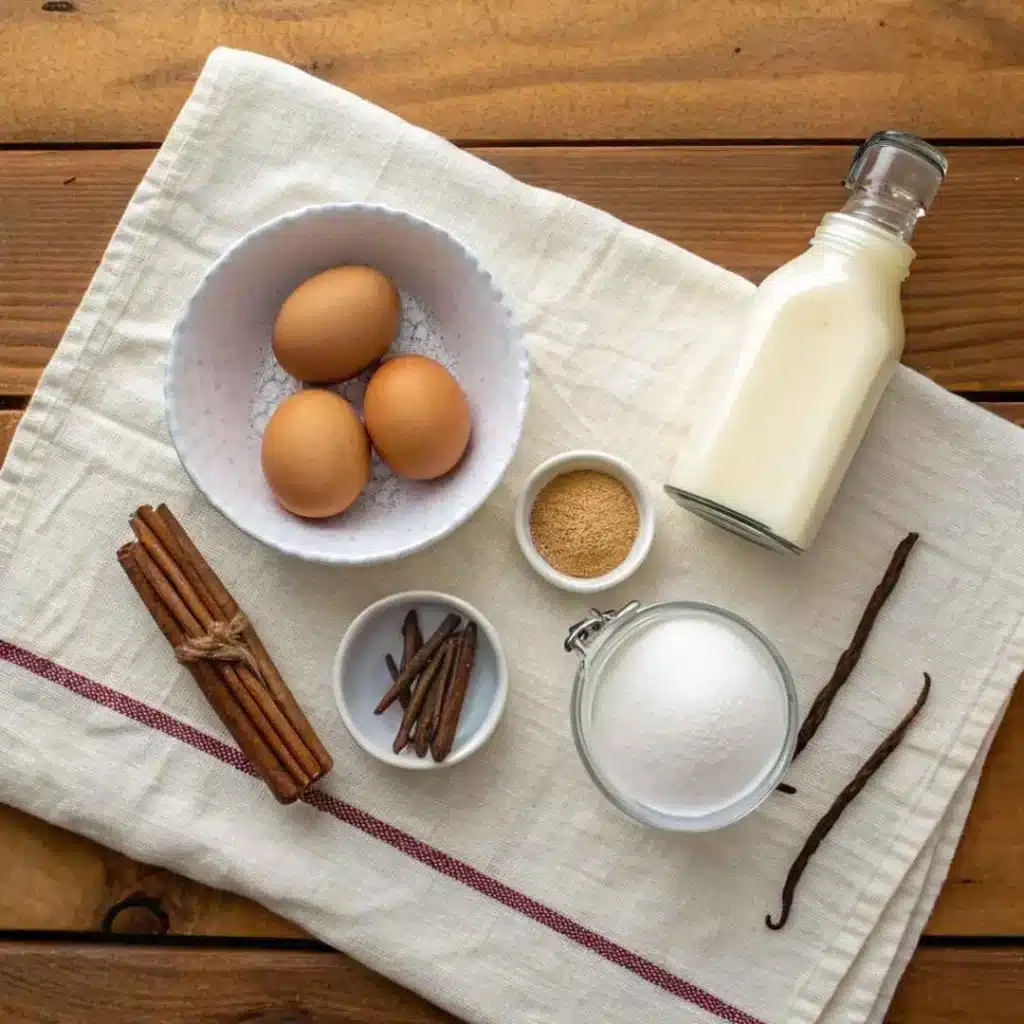
Ingredient tips for flavor and texture
Milk: Traditional jericalla is made with whole milk, which gives it that ultra-creamy texture. But if you’re avoiding dairy, oat milk is a great alternative. Just know that it’ll be slightly denser and a bit darker in color. Either way, the recipe holds up beautifully.
Sugar: Use regular white sugar. I haven’t tried it with alternatives like coconut sugar or erythritol because this dish really benefits from the neutral sweetness of cane sugar.
Cinnamon sticks: Please, skip the ground cinnamon. Using whole cinnamon sticks gives you that infused, comforting flavor without leaving specks in the custard.
Eggs: Some recipes use only yolks, but I find that using whole eggs gives it body and balance. Plus, it’s easier and less wasteful.
Vanilla: A good Mexican vanilla adds warmth and depth. But if all you have is standard vanilla extract, that’s totally fine.
Looking for more recipes with vanilla and cinnamon notes? You’ll love my arroz con leche—another nostalgic dessert that’s perfect for family dinners.
How to Make Jericalla – Step-by-Step
The classic method for an authentic jericalla recipe
Making jericalla is easier than you think, and the key to getting it right is patience. This isn’t a dessert to rush. But the process is calming—heating milk, whisking eggs, watching it bake slowly in the oven. Here’s how to do it the traditional way.
Step-by-step directions
Step 1: In a medium saucepan over medium-low heat, combine:
- 3 cups whole milk
- 1 cup sugar
- 2 cinnamon sticks
- 1 tsp vanilla extract
Stir gently and bring just to a boil. As soon as it starts to bubble, remove it from the heat and let it cool for 30 minutes. This step is crucial to avoid cooking the eggs later.
Step 2: In a large bowl, whisk 6 whole eggs until smooth.
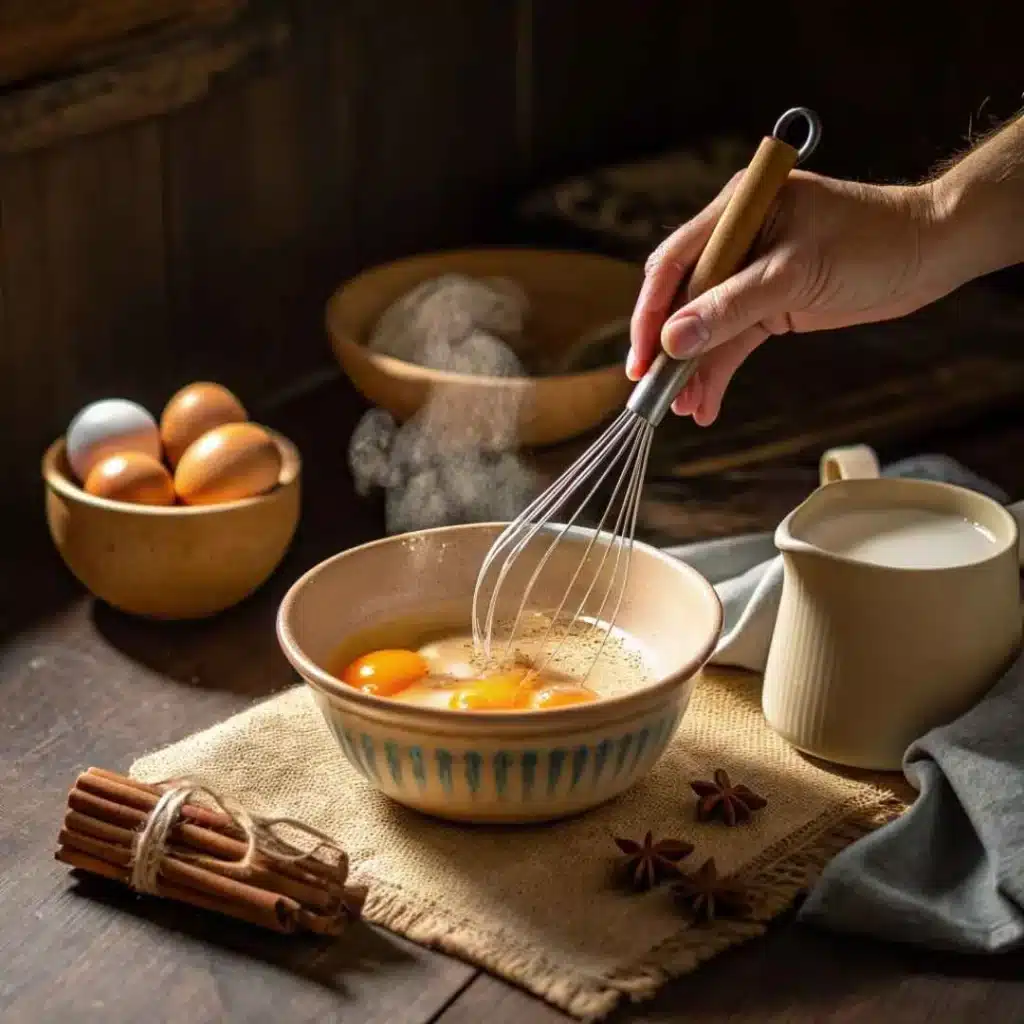
Step 3: Remove the cinnamon sticks from the milk. Slowly temper the eggs: add a few spoonfuls of the cooled milk mixture to the eggs while whisking continuously. This keeps the eggs from scrambling.
Step 4: Gradually whisk in the rest of the milk until fully combined.
Step 5: Preheat your oven to 350°F (175°C). Place 6 to 8 ramekins inside a deep baking dish and fill each one with the custard mixture.
Step 6: Create a water bath by adding hot water to the baking dish until it reaches halfway up the ramekins. Carefully transfer to the oven.
Step 7: Bake for 30 minutes (whole milk) or 45 minutes (oat milk). Check doneness with a toothpick—it should come out clean.
Step 8: Once baked, place ramekins under a broiler for 4 minutes to toast the tops. Let cool, then refrigerate for at least 2 hours before serving.
If you’re already craving another eggy Mexican classic, you might want to try this family-favorite Mexican flan recipe—silky, sweet, and just as simple to make.
Serving Jericalla, Creative Twists & How to Store It Right
How to serve jericalla like they do in Guadalajara
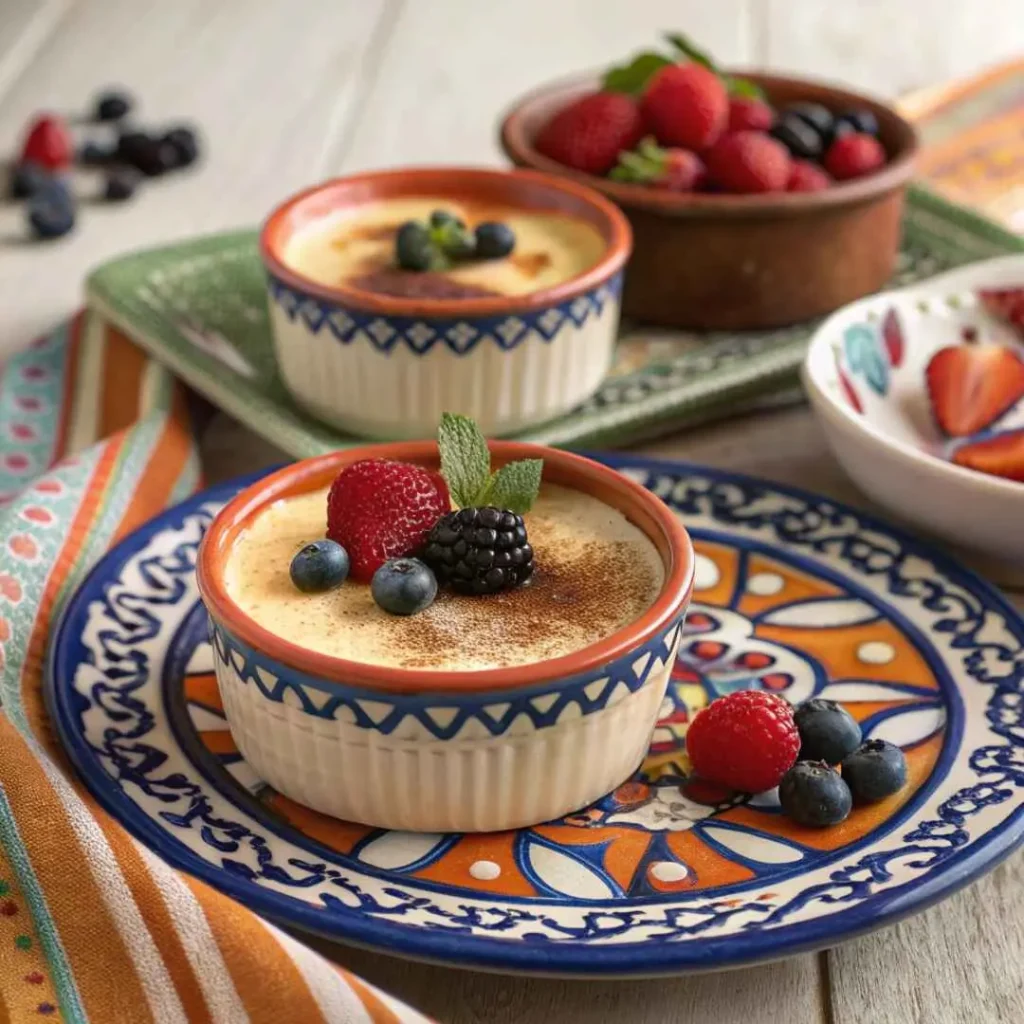
Traditionally, jericalla is served as is—no toppings, no unmolding, no frills. It’s typically baked and served right in the ramekin or small cup. But just like every family adds their own love to a dish, you can make it your own.
For presentation, I love topping each custard with a few fresh berries or a sprinkle of cinnamon. It’s not traditional, but it adds color and a light pop of freshness that balances the sweet, rich base.
And when you’re planning a dinner menu around this jericalla recipe, it makes a stunning yet simple finale after spicy tacos or a hearty Mexican stew.
Flavor variations worth trying
The base jericalla recipe is endlessly adaptable. Here are a few fun twists we’ve tried at home:
- Citrus zest: Add a bit of orange or lemon zest to the milk for a brighter flavor.
- Chocolate swirl: Add a spoonful of melted Mexican chocolate into the custard before baking for a decadent variation.
- Coffee infusion: Steep ground coffee or espresso in the hot milk for a café-flavored dessert (great for brunch!).
You can even mix jericalla into fusion-style desserts. One weekend, Grandma and I layered it with crumbled cookies and fruit—like a parfait. My daughter still asks for it that way.
Love discovering creative twists on Mexican desserts? You’ll adore our chocoflan recipe—a beautiful blend of cake and flan baked into one show-stopping treat.
Storage tips: How to keep it fresh
Once cooled, cover the ramekins tightly with plastic wrap or a lid. Jericalla lasts up to 3 days in the refrigerator. In fact, it’s best made ahead so it has time to set and chill. Avoid freezing—it affects the texture.
FAQs About the Jericalla Recipe
What are the ingredients in Jericalla?
The jericalla recipe uses five simple ingredients: whole milk, sugar, cinnamon sticks, vanilla extract, and whole eggs. Some versions allow oat milk for a dairy-free option. The key is in how they’re prepared—tempered gently and baked in a water bath.
What’s the difference between jericalla and flan?
Though both are Mexican custards, flan typically includes sweetened condensed milk and is topped with caramel sauce. Jericalla, on the other hand, is lighter and has a toasted top instead of a caramel layer. It’s served in the same dish it’s baked in and has a simpler, more rustic style.
What is the difference between crème brûlée and jericalla?
Crème brûlée includes heavy cream and has a torched, hard sugar crust on top. Jericalla skips the sugar topping and is broiled to get a burnt or browned finish. It’s less rich and more egg-forward in texture compared to crème brûlée.
Where did Jericalla originate?
Jericalla comes from Guadalajara, in the state of Jalisco, Mexico. Legend says it was created in a local orphanage by a Spanish nun who combined simple pantry staples into a nourishing dessert. It’s now a beloved regional sweet found everywhere from street carts to restaurants.
Conclusion: Jericalla—Where Simplicity Meets Tradition
This jericalla recipe isn’t just about eggs and milk. It’s about memory, comfort, and joy. It’s what we serve when we want to offer something made from love—not just for our family, but for our heritage. Whether you stick with the classic version or try a twist with citrus or chocolate, I hope it brings you the same warmth it brings to our home.
And if you’re looking for more heirloom desserts that are simple yet soulful, be sure to explore all our Mexican sweets—each one tells a story
Print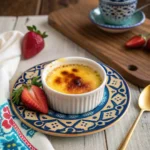
Jericalla Recipe: Traditional Mexican Custard with a Burnt Top
- Prep Time: 10 minutes
- Cook Time: 1 hour
- Total Time: 3 hours
- Yield: 8 servings 1x
- Category: Mexican Desserts
- Method: Baked
- Cuisine: Mexican
- Diet: Vegetarian
Description
This authentic jericalla recipe is a beloved Mexican custard from Guadalajara, flavored with cinnamon and vanilla and baked to a perfect toasted top. Easy to make with pantry staples and perfect for make-ahead desserts.
Ingredients
3 cups whole milk (or oat milk for dairy-free version)
1 cup granulated sugar
2 whole cinnamon sticks
1 teaspoon vanilla extract
6 large eggs
Instructions
1. In a saucepan, combine milk, sugar, cinnamon sticks, and vanilla over medium-low heat. Stir and bring to a gentle boil.
2. Once it starts boiling, remove from heat and let it cool for 30 minutes.
3. Whisk eggs in a separate bowl until smooth.
4. Temper the eggs by adding a few tablespoons of the cooled milk mixture while whisking constantly.
5. Slowly add the remaining milk to the eggs and whisk until smooth.
6. Preheat oven to 350°F. Place ramekins inside a large baking dish and pour custard mixture into ramekins.
7. Fill the baking dish halfway with hot water to create a water bath.
8. Bake for 30 minutes (whole milk) or 45 minutes (oat milk), until set.
9. Place under broiler for 4 minutes to create a browned top.
10. Chill in the refrigerator for at least 2 hours before serving.
Notes
Use Mexican vanilla and cinnamon sticks for traditional flavor.
Can be stored refrigerated for up to 3 days.
Top with berries or a sprinkle of cinnamon for added flavor and color.
Nutrition
- Serving Size: 1 ramekin
- Calories: 202
- Sugar: 30g
- Sodium: 82mg
- Fat: 6g
- Saturated Fat: 3g
- Unsaturated Fat: 3g
- Trans Fat: 0g
- Carbohydrates: 30g
- Fiber: 0.5g
- Protein: 7g
- Cholesterol: 134mg

